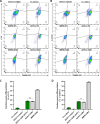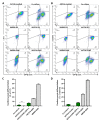Co-culture of induced pluripotent stem cells with cardiomyocytes is sufficient to promote their differentiation into cardiomyocytes
- PMID: 32243463
- PMCID: PMC7122760
- DOI: 10.1371/journal.pone.0230966
Co-culture of induced pluripotent stem cells with cardiomyocytes is sufficient to promote their differentiation into cardiomyocytes
Abstract
Various types of stem cells and non-stem cells have been shown to differentiate or transdifferentiate into cardiomyocytes by way of co-culture with appropriate inducer cells. However, there is a limited demonstration of a co-culture induction system utilizing stem cell-derived cardiomyocytes as a stimulatory source for cardiac reprogramming (of stem cells or otherwise). In this study, we utilized an inductive co-culture method to show that previously differentiated induced pluripotent stem (iPS) cell-derived cardiomyocytes (iCMs), when co-cultivated with iPS cells, constituted a sufficient stimulatory system to induce cardiac differentiation. To enable tracking of both cell populations, we utilized GFP-labeled iPS cells and non-labeled iCMs pre-differentiated using inhibitors of GSK and Wnt signaling. Successful differentiation was assessed by the exhibition of spontaneous self-contractions, structural organization of α-actinin labeled sarcomeres, and expression of cardiac specific markers cTnT and α-actinin. We found that iCM-iPS cell-cell contact was essential for inductive differentiation, and this required overlaying already adherent iPS cells with iCMs. Importantly, this process was achieved without the exogenous addition of pathway inhibitors and morphogens, suggesting that 'older' iCMs serve as an adequate stimulatory source capable of recapitulating the necessary culture environment for cardiac differentiation.
Conflict of interest statement
The authors have declared that no competing interests exist.
Figures






Similar articles
-
Inductive Coculture Differentiation of Induced Pluripotent Stem Cells into Cardiomyocytes.Methods Mol Biol. 2022;2454:117-126. doi: 10.1007/7651_2020_335. Methods Mol Biol. 2022. PMID: 33349904
-
Patient-Specific Induced Pluripotent Stem Cell Models: Generation and Characterization of Cardiac Cells.Methods Mol Biol. 2016;1353:147-62. doi: 10.1007/7651_2014_172. Methods Mol Biol. 2016. PMID: 25520292 Free PMC article.
-
Purification of small molecule-induced cardiomyocytes from human induced pluripotent stem cells using a reporter system.J Cell Physiol. 2017 Dec;232(12):3384-3395. doi: 10.1002/jcp.25783. Epub 2017 Apr 18. J Cell Physiol. 2017. PMID: 28063225
-
The Future of Direct Cardiac Reprogramming: Any GMT Cocktail Variety?Int J Mol Sci. 2020 Oct 26;21(21):7950. doi: 10.3390/ijms21217950. Int J Mol Sci. 2020. PMID: 33114756 Free PMC article. Review.
-
iPS cells: a source of cardiac regeneration.J Mol Cell Cardiol. 2011 Feb;50(2):327-32. doi: 10.1016/j.yjmcc.2010.10.026. Epub 2010 Oct 30. J Mol Cell Cardiol. 2011. PMID: 21040726 Review.
Cited by
-
Study of Stem Cells Influence on Cardiac Cells Cultured with a Cyanide-P-Trifluoromethoxyphenylhydrazone in Organ-on-a-Chip System.Biosensors (Basel). 2021 Apr 23;11(5):131. doi: 10.3390/bios11050131. Biosensors (Basel). 2021. PMID: 33922423 Free PMC article.
-
3D models of dilated cardiomyopathy: Shaping the chemical, physical and topographical properties of biomaterials to mimic the cardiac extracellular matrix.Bioact Mater. 2021 Jun 10;7:275-291. doi: 10.1016/j.bioactmat.2021.05.040. eCollection 2022 Jan. Bioact Mater. 2021. PMID: 34466733 Free PMC article. Review.
-
Highlights on Advancing Frontiers in Tissue Engineering.Tissue Eng Part B Rev. 2022 Jun;28(3):633-664. doi: 10.1089/ten.TEB.2021.0012. Epub 2021 Oct 25. Tissue Eng Part B Rev. 2022. PMID: 34210148 Free PMC article. Review.
-
Amnion-Derived Teno-Inductive Secretomes: A Novel Approach to Foster Tendon Differentiation and Regeneration in an Ovine Model.Front Bioeng Biotechnol. 2021 Mar 11;9:649288. doi: 10.3389/fbioe.2021.649288. eCollection 2021. Front Bioeng Biotechnol. 2021. PMID: 33777919 Free PMC article.
References
Publication types
MeSH terms
Substances
LinkOut - more resources
Full Text Sources
Other Literature Sources
Research Materials

